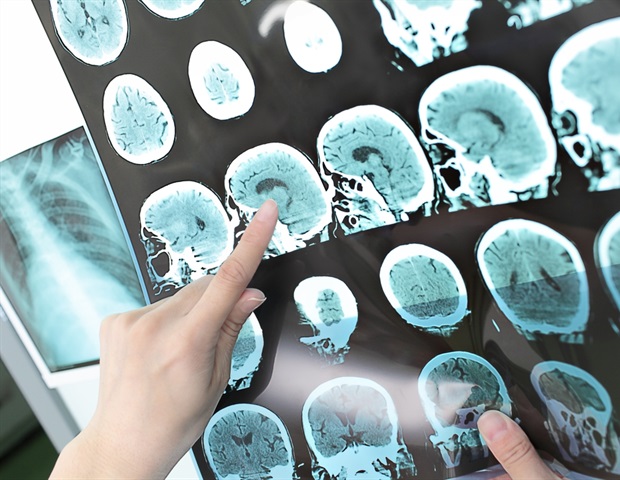A team of researchers from the Keck School of Medicine of USC and California Institute of Technology (Caltech) have developed a potential new way to measure a person’s stroke risk that is cost-effective and noninvasive, akin to a cardiac stress test. If validated through further tests, the device could transform stroke care, making early detection of increased risk a standard part of medical exams around the world.
Strokes are the leading cause of neurological disability. Close to 90% of them are caused by the reduction or blockage of blood flow to a part of the brain, leading to the death of brain cells. Currently, there is no widely accessible way to screen patients for physical signs that a stroke is likely to occur. Health care providers rely largely on indirect markers of stroke risk, such as details about a patient’s lifestyle and family history.
A cardiac stress test allows physicians to counsel patients about their risk for heart disease and to make decisions about treatments. If we can build a brain stress test equivalent that is scalable, affordable and noninvasive, that would make a massive contribution to public health.”
Charles Liu, MD, PhD, professor of clinical neurological surgery, urology and surgery at the Keck School of Medicine, director of the USC Neurorestoration Center and co-senior author of the new research
The USC Neurorestoration Center took on that task as part of its larger mission to address critical unmet needs in neurological care. Liu and his colleagues built a device, worn like a headband, that uses a series of lasers and cameras to collect images of the brain through a technique known as speckle contrast optical spectroscopy (SCOS).
In a proof-of-concept study of the new device, funded in part by the National Institutes of Health, the researchers recruited 50 participants to complete a breath-holding “stress test” for the brain while wearing the device. The team found that the SCOS device could differentiate people with high stroke risk from those with low risk based on changes in blood flow and volume during the stress test. The results were just published in the journal Biomedical Optics Express.
More research is needed to refine the test’s parameters and to confirm its utility in a larger population, but it holds the potential to revolutionize stroke care, Liu said. The device could help providers assess the risks and benefits of various medical treatments, such as whether to prescribe blood thinners, depending on a person’s individual stroke risk. It might ultimately provide more reliable data than existing questionnaires, and it is affordable and portable enough that it could quickly become widespread.
“This is so simple that you can imagine it being included in your annual physical, along with measuring your weight and blood pressure,” Liu said.
A stress test for the brain
To conduct preliminary tests of a new technology, researchers often begin by comparing its predictions to a widely accepted test that is already available. In the present study, Liu and his team used the Cleveland Clinic Stroke Risk Calculator, a questionnaire commonly used by physicians, to select 25 participants with low stroke risk and 25 who were high risk.
The researchers then used a special SCOS method developed by the study’s co-senior author, Changhuei Yang, PhD, a professor of electrical engineering, bioengineering and medical engineering at Caltech. The technique transmits lasers through the brain, using cameras to measure how the laser light scatters when it hits an object (in this case, blood cells as they flow through the brain). By measuring blood flow and volume, the researchers can then calculate blood pressure in the brain’s vessels.
Liu and his team used the SCOS device to collect images from the brains of participants at rest, then again during a neurological “stress test,” where participants held their breath for as long as they could tolerate. Breath-holding temporarily puts the brain under stress in order to reveal its vulnerabilities, similar to the way running on a treadmill taxes the heart during a cardiac stress test.
Compared to participants in the low-risk group, those in the high-risk group showed significant differences in blood flow and volume during the stress test, indicating steeper increases in blood pressure. Those findings suggest that the new approach has utility for assessing stroke risk.
Refining the tool
The SCOS device could provide a much easier way to assess a patient’s stroke risk than currently available methods. Today, health care providers use expensive tests, such as magnetic resonance imaging (MRI) or computed tomography (CT), to view the brain’s blood vessels. But the new technology is simple, affordable and portable enough to be scaled across primary care offices, emergency departments and community clinics, as well as to less developed countries.
Next, the research team will work to refine the technology and prepare it for clinical use. They will conduct a clinical trial among a larger group of patients, tracking progress over two or more years to examine how changes in stress test scores relate to real-world health outcomes.
Liu and his colleagues, who include the Keck School of Medicine’s Jonathan J. Russin, MD, an associate professor of neurological surgery, and Patrick Lyden, MD, a professor of physiology and neuroscience and neurology at the Zilkha Neurogenetic Institute, will also begin using machine learning to improve how the test analyzes and learns from the data it collects.
About this research
In addition to Liu, Yang, Russin and Lyden, the study’s other authors are Aidin Abedi and Yu Tung Lo from the USC Neurorestoration Center, Keck School of Medicine of USC; and Yu Xi Huang, Simon Mahler and Julian Michael Tyszka from the California Institute of Technology, Pasadena, California.
This work was supported by the National Institutes of Health [5R21EY033086-02] and the USC Neurorestoration Center.
Source:
Journal reference:
Huang, Y. X., et al. (2024) Correlating stroke risk with non-invasive cerebrovascular perfusion dynamics using a portable speckle contrast optical spectroscopy laser device. Biomedical Optics Express. doi.org/10.1364/BOE.534796.
Source link : News-Medica

